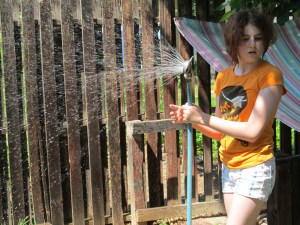We had a hailstorm last night- after a lovely, breezy day with lots of garden puttering, I was sitting on my patio, listening to the neighbor kids scream on their trampoline. I heard thunder to the south and decided to move in. By the time I gathered up my iced tea and got the screen door shut, the rain had started, and then came the hail.
Kate decided it would be cool to go out onto the porch, then regretted it almost instantly- it was being blown under the roof. She struggled with the screen slider, and got hit in the shoulder. The stones were dime to quarter-sized, and they shredded the garden. Giant splashes came up from the pond, the iris and the peonies flopped over, ash leaves made pesto on the driveway. Looking at it through the window, I wanted to cry. I wanted brownies. I hate hail.
It poured rain for a good long time after, and we got probably another 1/2 inch, on top of the five inches we got during a very wet May. We usually get about 16 inches of moisture around here per year, so 5 inches in a month is crazy- the soil is saturated and there has been flooding downstream from us.
Now it’s the day after, and I hear a chainsaw going around the block. I take a tour of the yard with a cup of coffee.
Not actually that bad. Here’s where I get to my point about resilience.
The water lily leaves have holes in them, but none of the fish are belly up in the pond, the iris are still flopped over, but they were pretty much finished blooming anyway. The few peonies that had opened are shattered, but the rest that are still in bud look fine.The new baby peach tree seems fine, with just a few torn leaves. The giant ash trees took most of the brunt of the storm, most of what was in their shelter is okay, and no large branches fell down. Tomatoes were in walls of water, which protected them from damage. The traditional, “grandma’s garden” types of plants show damage, but they should bounce back.

Supposed to keep the tomatoes warm at night, also protects against balls of ice falling from the sky, apparently.
Now, I planted a garden bed last year, in full sun, no shelter from big trees, of mostly native and dry-land plants. How did these baby plants do? They look fine. I can’t tell they were in a storm at all, other than the fact that there are some shredded leaves that were blown onto them. These native plains plants have evolved to get hailed on periodically, go without rain, shrug it off and grow anyway.
I got my collection from the Garden in a Box program from the city- sometimes you can get rebates. The garden was designed by Lauren Springer, and cost less than what I would have paid at a nursery. The water department wants people to plant them to minimize the amount of turf that people feel obliged to water. The side benefit is that they are resilient to other weather events, too.

We happen to live in a hail zone, with frequent thunderstorms, and infrequent (fingers crossed) tornadoes. Maybe your extreme weather events include blizzards, or floods, deep freezes, droughts (I’m looking at you, most of American Southwest). Why not plant things that thrive in the weather that you have? Plant things that have evolved, or have been bred, in a climate like yours, that don’t take additional irrigation once they have been established. For my homies along the Front Range, Lauren Springer has books ( go to the library, I don’t make any money off this, not that you shouldn’t buy the book, but libraries are good, too) or David Salman runs a Santa Fe nursery called High Country Gardens. His catalog is an education in itself. Bounce back after sever weather. Resilience. You can Grow that.
On the 4th of the month, C.L. Fornari challenges garden bloggers to share encouraging words about what is growable. Search for other You Can Grow That posts!













